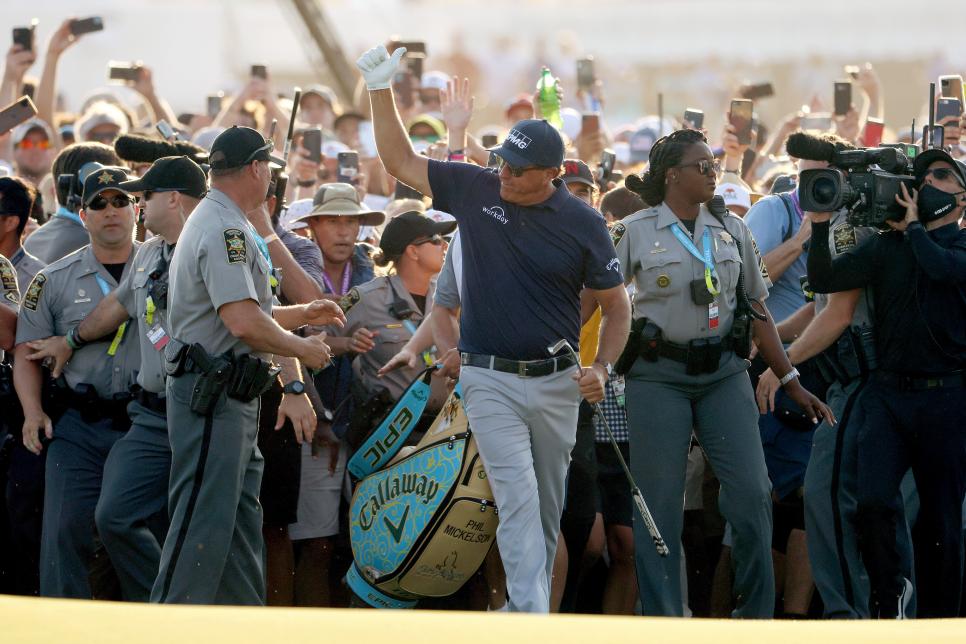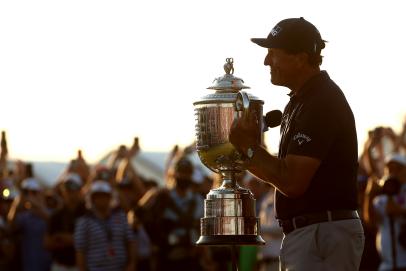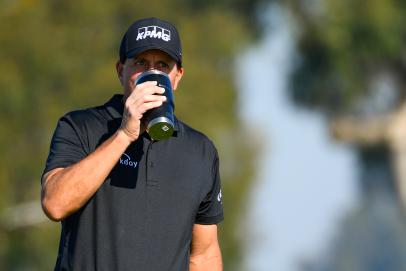Phil Mickelson’s victory at the PGA Championship in May, where at 50 he became the oldest winner of a golf major, wasn’t the result of getting hot at the right time. This win was two years in the making, the result of adopting several life-changing strategies that enabled him to compete against players roughly half his age. This was no four-round fluke, says his doctor, Ara Suppiah.
“To compete at the highest level, Phil wanted to do more to relieve the psoriatic-arthritis pain he had been suffering from for more than a decade,” says Dr. Suppiah, a medical consultant for Golf Digest and the physician for six Ryder Cup teams. “He also wanted to lose weight, get stronger, think more clearly, reduce stress and inflammation and swing the club like he did in his 30s and early 40s, if not better.”
You can guess that his plan included a healthier diet and more exercise, but Mickelson didn’t stop there. With the advice of Dr. Suppiah, Sean Cochran (his trainer) and other advisors, he implemented everything from pulsed electromagnetic-field therapy for pain management to intermittent fasting to combat lethargy to neurological breathing techniques for improved focus. He even started to meditate. In this article, Dr. Suppiah will reveal everything Mickelson did in his quest and why it worked, so you can decide if a similar track will help you feel and play like your younger self.
“Before I do, I have to put on my doctor’s coat—you should see your primary-care physician before attempting to copy any of Phil’s strategies,” says Dr. Suppiah, who also is an emergency-room doctor. “I’m serious. I’ll give you a sobering example of why you need to get cleared by a doctor. If you have diabetes or are prediabetic, fasting like Phil could cause seizures, loss of consciousness or even death.”
That warning aside, Dr. Suppiah says Mickelson’s strategies worked very well. Thanks to his dedication, you wouldn’t know Phil turned 51 on June 16 by any indicators other than his wisdom and his driver’s license.
ATTACKING INFLAMATION
The chronic pain Mickelson feels from arthritis, overuse stress, and other debilitating issues from aging has slowly subsided because of several strategies including famously taking the medication Enbrel and two lesser used treatments—red-light therapy and electromagnetic therapy.
Red-light therapy is thought to accelerate the healing process of skin, soft tissue such as tendons, muscle and fascia as well as other parts of the body, Dr. Suppiah says. Mickelson exposes specific areas of pain to low levels of infrared light, which is thought to power up mitochondria, providing the energy necessary for healthy cellular function. Healthy cells suppress pain and disease. The treatments are considered safe, and you can buy the transmitters online. You don’t need to see a doctor, Dr. Suppiah says.
The same goes for pulsed electromagnetic-field therapy (PEFT). No doctor is required, although Suppiah wouldn’t recommend this if you have a pacemaker and haven’t been cleared by a physician. PEFT is thought to jump-start the healing process by using magnetic fields to improve blood flow, most notably at the capillary level of the vascular system where tissue receives nutrients. Players who suffer from common golf injuries such as shoulder or elbow tendonitis often find relief from this type of therapy, Dr. Suppiah says.
“Perhaps the most important thing Phil does to reduce inflammation is taking his sleep more seriously. I can’t stress enough the importance of rest and recovery on an aging athlete,” says Dr. Suppiah, physician to several pro golfers and tennis players.
“Usain Bolt, perhaps the fastest human ever, once said more than 50 percent of his training was simply allowing his body to absorb the demands he put on it. Phil recognized that a big part of performance excellence is proper rest. You should, too.”
LOSING WEIGHT
If you’re older than 40, eating cleaner and losing weight are going to make a noticeable difference in how you feel and could positively impact how you perform on the golf course. “As much as Phil likes to eat, he knew he had to implement a more restricted diet, so he sought the advice of a nutritionist to test for and identify foods that agree and disagree with his digestive system,” Dr. Suppiah says. You can guess that Phil’s taste for wine wasn’t the best if he wanted to reduce inflammation, but believe it or not, there were many other things he ate or drank that might seem healthy yet made him feel terrible. Some people struggle to digest certain foods. “I’m sure you’ve heard of people who have to avoid dairy products,” Dr. Suppiah says. “Eating the wrong things can result in a host of health issues.”
Mickelson settled on an eating plan that resembles a Mediterranean diet: fish, nuts, green vegetables, oils, etc. That might not be the best menu for you, Dr. Suppiah says, and you probably already have a good idea about what foods make you feel bloated or upset your stomach. Another key is portion control. Mickelson’s plates are not overloaded.

At 51, Mickelson might be the fittest he has been since turning pro in 1992. Photographs by 1994: Gary Newkirk/AllSport/Getty Images, 2006: Dom Furore, 2020: Gregory Shamus/Getty Images
Once every week or two, he also stops eating solid foods for 36-hour stretches. All he has during that time is water and coffee. Coffee is the key, Mickelson says. He was advised that drinking more of it (along with ingesting green-tea extract) would boost his immune system. Not just any coffee, mind you, but a special recipe that includes a long list of additives: protein powder, sea salt, almond milk, triglyceride oil, honey, cinnamon and the amino-acid supplement L-theanine. Each ingredient (see “Phil’s cup of Joe,” below) has a special purpose like inflammation control and allergy and appetite suppression, and Mickelson says the calories are enough to keep him going even when he’s playing. It’s certainly no coincidence that he has since started a business with golf instructor Dave Phillips called Coffee for Wellness. Why not profit on good health?

PHIL'S CUP OF JOE
1. 12-16 ounces of strong coffee from Ethiopian beans
2. A few tablespoons of triglyceride oil (medium chain) to accelerate fat burning and counter hunger pangs
3. A scoop of the amino acid L-theanine to control anxiety and coffee jitters
4. A scoop of unflavored collagen protein powder for soft-tissue repair
5. A spoonful of Manuka honey to subdue allergies
6. A spoonful of cinnamon to reduce inflammation
7. A dash of pink Himalayan salt for electrolytes, decreasing risk of dehydration
8. Unsweetened almond milk for flavor
Back to the benefits of intermittent fasting, Dr. Suppiah says it also helps the body function at the cellular level by replacing dysfunctional mitochondria. For those struggling with weight gain, it also can help stabilize blood-sugar levels. As he mentioned, Dr. Suppiah wouldn’t recommend intermittent fasting for anyone with diabetic issues or if you suffer from stomach ulcers. The triglyceride-oil additive in his coffee (MCT) is not recommended for anyone with high triglycerides or fatty-liver disease or people at a higher risk for a heart attack or a stroke.
If you are wondering how Mickelson deals with the hunger pangs you might get from fasting, he says he doesn’t really notice them anymore. In fact, he feels like he has more energy and is better rested. That makes sense, Dr. Suppiah says, since his body doesn’t have to deal with the digestive process multiple times like it does on a normal day: “You probably haven’t thought about it much, but the physical act of digesting food can disrupt just about anything: sleep, exercise, concentration,” he says.

Breathing techniques helped Phil stay focused at the PGA in May. Photograph by Jamie Squire/Getty Images
REDUCING STRESS
When you think of stress, you might imagine the worries you feel over work, money, your kids, etc. Stress actually manifests from many aspects of life—physical and mental. What Mickelson did was identify all the things that taxed him—everything from fatigue and allergies to media requests to intense competition—and tried to remove little things from each of those stress buckets, Dr. Suppiah says. For example, his goals of better nutrition and rest and reducing inflammation also have a positive impact on tension and anxiety. “He also tackled stress by meditating for about 45 minutes every morning and adding L-theanine to his coffee, which is thought to calm the nervous system,” Dr. Suppiah says.

Suppiah, the doctor for six Ryder Cup teams, holding the trophy in 2016. Photo courtesy of Dr. Suppiah
You also might have noticed Mickelson chewing gum when he plays. The gum he uses includes CBD, the main non-psychoactive ingredient in marijuana. CBD also is believed to help subdue the nervous system, and the simple acting of chewing helps relax the jaw and calm brain activity by triggering the mental state that food is on the way, Dr. Suppiah says.
He also uses a breathing technique in competitions that puts him in more of a Zen state of mind—especially in the most important moments of a round. On Sunday at the PGA Championship at Kiawah Island, you could see that Mickelson would take a breath and then breathe out as slowly as he could. Prolonging the expiration slows down the heart rate, and that reduction in electrical activity helps sync it with the brain, Dr. Suppiah says, “and that’s when Phil is able to block out distractions and really focus on what he wants to do from shot to shot. Controlling your sympathetic nervous system is going to keep you grounded as you play and let you access your physical skills much easier, like when you’re hitting shots on the range.”
GETTING STRONGER
It should be obvious that if you’re older than 40 and want to play like you used to, you need to work out more—and not just stretching and some time on the treadmill or stationary bike. Mobility and cardiovascular health are important, but not the most important for preserving physical skill as you age, Dr. Suppiah says.
Mickelson’s workouts with performance specialist Sean Cochran instead focus on heavy weight lifting and preserving fast-twitch (Type 2) muscle fiber. The latter task is super important as you get older because those fibers—the very things you need for swing speed—rapidly vanish as you age (sarcopenia), and you can’t get them back. You can still train what you have left, however, and that might be enough to preserve your current swing speed, or even improve it, with the right type and amount of training. It’s a case of use it or lose it.
Mickelson is a dedicated early morning exerciser on weekdays, Cochran says, and when he shows up at the gym, he comes to sweat. His sessions typically last 60 to 90 minutes and include a variety of exercises meant to deal with aging (see “Phil’s typical offseason workouts,” below). He will start with foam rolling or other forms of myofascial release (think self-massage), do some static stretching, and then transition into a more dynamic warm-up, exercising in all three planes of motion. “The point is to prep his body for the more vigorous part of his workout,” Cochran says, “and what is required in a proper swing when you’re moving laterally, rotationally, vertically. ” From there, he will finish his prep work by doing a series of what Cochran calls “joint-integrity exercises,” trying to keep things like the pelvis and shoulders as strong and functional as possible—knowing that they can be problem areas for aging golfers who neglect them.
During down times from competition, Mickelson transitions his workout to power exercises. These are the movements that help improve fast-twitch fiber. As you might expect, Mickelson focuses on exercises that boost the multi-plane movements of golf and help recruit more power from his body and the ground—things like medicine ball rotational throws for his upper body and box jumps for his lower body (yep, Mickelson can still get off the ground). Speed is the key to these moves, so he does them using only light resistance.
Finally, his workouts wrap up with core-strengthening exercises and strength training with heavy weights done in low repetitions (squats, rows, deadlifts, overhead presses, etc.). Mickelson uses dumbbells, kettlebells, cable machines and a landmine and lifts about 80 to 85 percent of his maximum load.
“Excuse the food pun, but I realize all of this is a lot to digest—especially if Phil’s success has inspired you to re-examine your habits; I get it,” Dr. Suppiah says. “With medical approval, it might be best to slowly implement these strategies. Maybe start with eating healthier and reducing calories and generally trying to feel better. Then maybe get back in the gym and take rest more seriously. You can try any or all of these strategies to see what kind of impact they have on your life.”
If you need a simpler plan, Dr. Suppiah says you also can perform better and live healthier if you just remember to focus on these six things every day: nutrition, hydration, sleep, sunlight, movement and human connection.
“That’s the easiest way to be like Phil,” he says.



